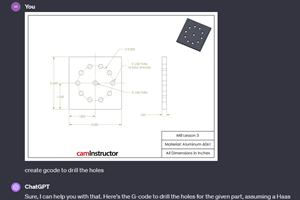Under Pressure
Using an integrated, single-window solution can alleviate programming bottlenecks, making the transition from design to manufacturing smooth.
Share





At Alpha Engineering and Design (AED; Fort Collins, Colorado) a programming bottleneck was an impediment to fulfilling a goal of doubling capacity. That bottleneck involved adapting to engineering changes in a way that didn’t introduce error. In addition to constraints such as short leadtimes and tight tolerances, AED is a company that cannot afford to tolerate scrap.
AED produces vacuum chambers that, from the perspective of most manufactured products, can contain no imperfections whatsoever. Tiny scratches must be polished, and a leak much smaller than a human hair is considered grossly unacceptable. Even the oil from one’s finger is considered an offensive contaminant.
Reject The Disconnect
Greg Jackson, owner and design engineer at AED, says that while the process of testing and editing G code can be cumbersome, making design changes when the part is already in production is even more problematic. He explains that deducting minutes from machining processes is somewhat peripheral to the concerns of his high-precision shop. Instead, he finds value in being able to better serve his core market by quickly making engineering changes.
In the past, once work began on a CAM part program, the operator would have to start over and redo all of the programming work if the design were to change. The shop’s disconnect between its CAD program and its CAM system would also be inconvenient for repeat projects in which just small details would be modified. If the operator would try to make the small detail changes by editing an existing program, then AED would need to be able to document those changes after tinkering with the code.
Serving Science
In operation since 2000, AED serves the semiconductor/thin film coating industry as well as high-tech industries involving vacuum-environment research and development. The shop, which generally produces small quantities of high-precision parts such as vacuum chambers and hinge and O-rings, has extensive engineering expertise in this particular market. Part runs generally range from 1 to 100. The company designs and integrates turnkey packages, meaning that AED offers the pumps, electronic controls, all of the wiring and the software program for the vacuum system. The chamber is then ready to produce parts once it lands at the customer’s shop.
A healthy percentage of the company’s work is related to space simulation. AED also has constructed chambers to test propulsion systems and guidance systems for missiles, as well as to test satellites for one customer in particular. Chambers are also employed for vapor deposition purposes, such as that for decorative products.
Once housed in an 2,000-square-foot facility, the company now occupies a total of 12,000 square feet, which includes fabrication areas that contain an LVD press brake and custom waterjet machine. The company’s staff has also grown from eight to 12 members.
AED sometimes receives design data from customers as SolidWorks files. Often enough, though, the starting point can be as rudimentary as working from hand gestures, or it can involve detailed blueprints in which each nut and bolt has been accounted for and categorized. In these cases, the shop creates the CAD models itself using SolidWorks. In any case, though, the designs of these complex products are subject to frequent and ongoing modifications. With a previous CAM system, frequently re-creating NC programs to accommodate changes caused delay and the potential for confusion. The company’s solution was SolidCAM (Croydon, Pennsylvania), a CAM system that integrates with SolidWorks and talks back and forth with it.
About 50 percent of the company’s chambers are aluminum, whereas the remaining 50 percent are typically stainless steel. Many of the one-piece units measure 10 to 15 feet long, with diameters ranging in size from that of a human hand to 6 feet. The 10-foot sections can be welded together to make even larger chambers.
Primary considerations when manufacturing these vessels are 1) helium leak testing and 2) welding integrity. A leak measuring the size of a human hair is grossly unacceptable. A helium mass spectrometer is sensitive to even miniscule leaks. For example, the tool can reliably detect leaks in the 10-11 cubic centimeter per second (cc/sec) range . This means that the leak would be so small that it would fill 1 (cc/sec) in 3,300 years.
“Helium is traditionally the element of choice because it is one of the lightest molecules,” says Mr. Jackson. “In addition, it is inert, so there are no corrosive issues.”
Rolling With Design Changes
SolidCAM is employed to program the company’s Toshiba boring mill and its smaller machining centers. AED also uses MasterCAM from CNC Software, Inc. (Tolland, Connecticut) to program its fabricating equipment, which includes a custom waterjet and an LVD press brake.
James Thompson, former vice president of operations at AED, cites SolidCAM’s integrated interface as a means of virtually seamless transition from the 3D design model to CNC programming.
When the geometry that is used to define a machining operation is changed in SolidWorks, SolidCAM enables the user to synchronize all machining operations with the updated geometry. Formerly, the operator would need to begin again with the CAM work if adjustments were necessary.
Now, the user can make adjustments to the model and let programming-related changes follow through. Mr. Thompson says that SolidCAM then automatically updates the NC program so that a simulation can quickly be performed.
“If it looks good, then I can proceed with the job and just press run,” he said.
The company adds that multiple configurations can be used in one CAM part program. Each configuration can represent an independent state or production step of a workpiece. This level of associativity with the SolidWorks design reduces errors when the model family changes. It also facilitates the process when updates are received for a variety of related models that the shop has produced in the past.
Related Content
Can ChatGPT Create Usable G-Code Programs?
Since its debut in late 2022, ChatGPT has been used in many situations, from writing stories to writing code, including G-code. But is it useful to shops? We asked a CAM expert for his thoughts.
Read MoreSetting Up the Building Blocks for a Digital Factory
Woodward Inc. spent over a year developing an API to connect machines to its digital factory. Caron Engineering’s MiConnect has cut most of this process while also granting the shop greater access to machine information.
Read MoreThe Power of Practical Demonstrations and Projects
Practical work has served Bridgerland Technical College both in preparing its current students for manufacturing jobs and in appealing to new generations of potential machinists.
Read MoreHow this Job Shop Grew Capacity Without Expanding Footprint
This shop relies on digital solutions to grow their manufacturing business. With this approach, W.A. Pfeiffer has achieved seamless end-to-end connectivity, shorter lead times and increased throughput.
Read MoreRead Next
Machine Shop MBA
Making Chips and 91ĘÓƵÍřŐľÎŰ are teaming up for a new podcast series called Machine Shop MBA—designed to help manufacturers measure their success against the industry’s best. Through the lens of the Top Shops benchmarking program, the series explores the KPIs that set high-performing shops apart, from machine utilization and first-pass yield to employee engagement and revenue per employee.
Read MoreLast Chance! 2025 Top Shops Benchmarking Survey Still Open Through April 30
Don’t miss out! 91ĘÓƵÍřŐľÎŰ's Top Shops Benchmarking Survey is still open — but not for long. This is your last chance to a receive free, customized benchmarking report that includes actionable feedback across several shopfloor and business metrics.
Read MoreAMRs Are Moving Into Manufacturing: 4 Considerations for Implementation
AMRs can provide a flexible, easy-to-use automation platform so long as manufacturers choose a suitable task and prepare their facilities.
Read More





















